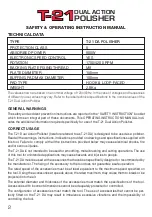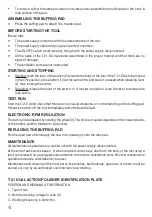
4
•
To remove, follow the same procedure in reverse order; assemble the buffer pad on the hook &
loop surface of the pad.
ASSEMBLING THE BUFFING PAD
•
Press the buffing pad to attach it to the disc pad.
BEFORE STARTING THE TOOL
Ensure that:
•
The power supply conforms with the characteristics of the tool;
•
The power supply cable and plug are in perfect condition;
•
The ON/OFF switch works properly though with the power supply disconnected;
•
All the parts of the T-21 DA have been assembled in the proper manner and that there are no
signs of damage;
•
The ventilation slots are not obstructed.
STARTING AND STOPPING
•
Starting: push the lever of the switch (2) towards the body of the tool; if the T-21 DAis to be locked
in the ON position, press button (13) at the same time and keep it pressed while releasing lever
(2), thus locking the switch.
•
Stopping: release the lever of the switch, or if locked in position, push the lever to release the
lock button.
TEST RUN
Start the T-21 DA and check that there are no unusual vibrations, or no mismatching of the buffing pad.
Otherwise switch-off the tool immediately and eliminate the fault.
ELECTRONIC RPM REGULATION
The rpm can be adjusted by rotating the wheel (3). The choice of speed depends on the characteristics
of the buffers and the material to be worked.
REPLACING THE BUFFING PAD
Pull the used pad off and apply the new one, pressing it onto the disc pad.
MAINTENANCE
All maintenance operations are carried out with the power supply disconnected.
At the end of each work session, or when required, remove any dust from the body of the tool using a
jet of compressed air, paying particular-attention to the motor ventilations slots. No other maintenance
operations must be undertaken by the user.
Maintenance and cleaning of the inner parts, like brushes, ball bearings, gears etc. or others, must be
carried out only by an authorized customer service workshop.
T-21 DUAL ACTION POLISHER IDENTIFICATION PLATE
POSITION AND MEANING OF INFORMATION
1 - Type of tool.
2 - Nominal working voltage in volts (V).
3 - Working frequency in hertz (Hz).


























